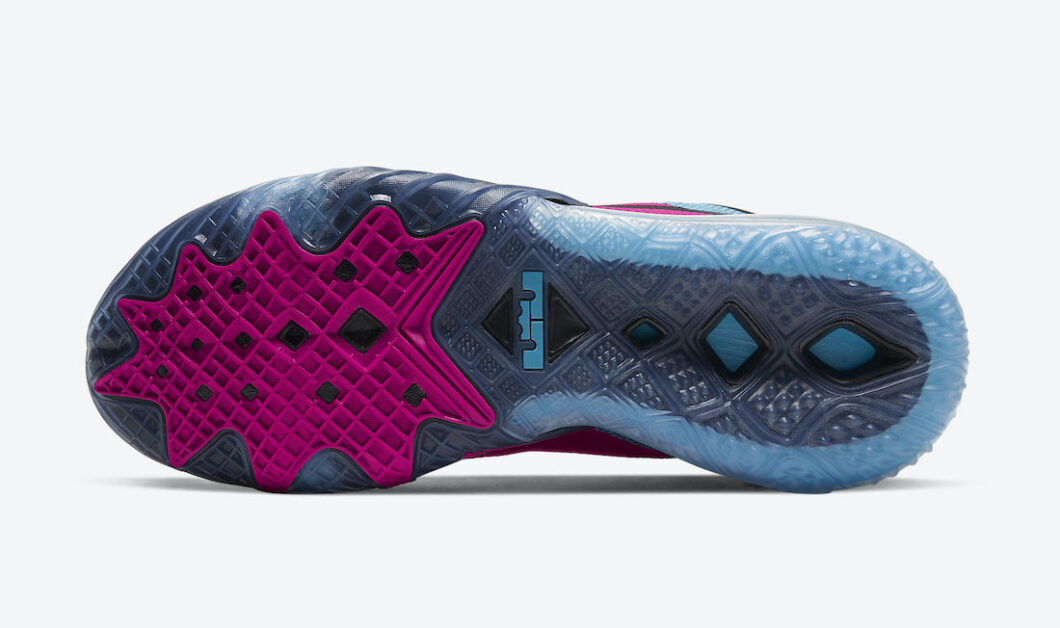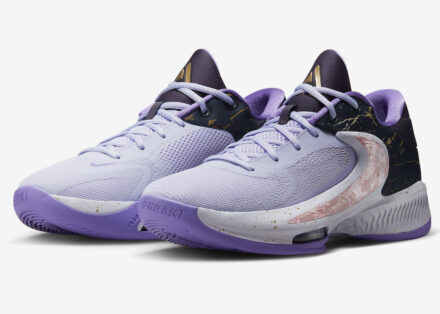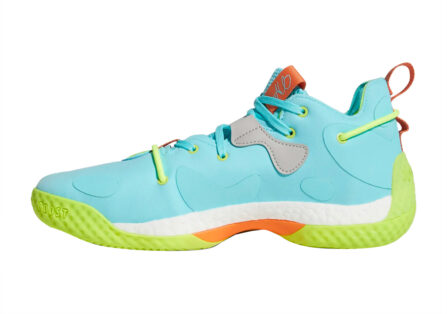
TRACTION
Although it received a little tweak with the design on the outsole, the traction pattern of the Nike LeBron 18 Low is almost similar with the original version appearance-wise. The pair has an additional abstract design, along with the square patterns on the forefoot and the nubs on the heel portion.
The outsole is very competitive and it grips well whether being used indoors or outdoors. The pair’s lateral stop is good and does not have any delays or slides while being supported and contained by the fuse-like material. Surprisingly, the traction of the Nike LeBron 18 Low is a notch higher than the Nike LeBron 18 only because in the original version, you can actually experience some slides during stops. It’s noteworthy that the LeBron 18 Low’s traction performance is very much consistent.
The only downside of the outsole is that the rubber compound is too soft. The outsole gets easily worn out overtime when used outdoors, especially if the player loves to drag or slide. Well, it is normal for outsoles to get worn out when used outdoors but the main concern will always be the durability. For a US$160 pair, it’s not very smart and practical to burn out the rubber compound in just a few games.
While there are no major concerns with the outsoles except for its durability, it’s still very advisable to give more time using this pair indoors rather than playing on blacktops. To preserve the lifespan of the pair, we strongly suggest a wider sneaker rotation, especially when you have more access playing outdoors.
But if you’re just after a competitive and consistent traction without actually minding if the outsoles will get scoffs and drags in a short period of time, and if the price of the pair will never be an issue, then the ball is on your court.

CUSHION and SUPPORT
When it comes to LeBron shoes, particularly its main signature line, Nike never cuts corners when it comes to the cushioning technology. In addition, it’s no secret that LeBron is a huge fan of the Zoom Air technology, so it is and will always be the main inclusion when it comes to the Lakers superstar’s signature pairs.
The Nike LeBron 18 Low is not an exemption to that rule.
The LeBron 18 Low is infused, as expected, with the Nike Zoom Air Max technology on the heel portion, along with a full-length Nike React cushion. Without any exaggeration, both the Nike Zoom Air Max tech and the Nike React cushion are among the best cushion technologies ever created by Nike due to their superb impact protection and jelly-like bounciness.
Not to rain on anybody else’s parade, but not all combinations of the best technologies can totally equate to a perfect performance. See the Under Armour Curry 7 as an example, with the lowly integration of the brand’s best performing cushion techs, the Micro G and the HOVR.
Under Armour’s Micro G and HOVR, just like the Zoom Air and React, are known as soft and responsive cushion technologies. But when they were infused in the Under Armour Curry 7, they turned out to be a bit of a flop due to the stiffness and unresponsiveness. While it is Stephen Curry’s preference to use stiff cushion, it was still both lackluster and disappointing performance-wise, knowing the good reputation that the Micro G and the HOVR have.
On the contrary, the Nike LeBron 18 turned out to be very responsive and a bit too bouncy that the pair’s cushion was forced to have some minor flaws which yet could result into something fatal on the user’s end. This might sound exaggerated for some but don’t forget that in sneakers, too much of something could downgrade the overall performance of the pair.
Still, the LeBron 18 Low’s cushion performance is not as bad as it seems. To be honest, it performs very well. The integration of the Zoom Air Max unit and React tech is undoubtedly very comfortable. It feels like you are jumping on a mattress with how soft and responsive the cushion tech is.
However, there are some negative takeaways that are worth jotting down before you consider buying a pair.
There was a tiny flaw with how these cushion techs were infused. If you are paying close attention, we mentioned that the pair is infused with a full-length Nike React cushion. Yes, full-length. Unlike in the Under Armour Curry 7 wherein the Micro G and HOVR were infused in two opposite sides without overlapping. In the LeBron 18 Low, the Nike React was fully-infused on the forefoot area then became very thin to fit at the top of the Zoom Air Max unit on the heel portion.
This set-up allows the user to experience maximum compression and comfort. However, this same exact set-up is the reason why the Nike LeBron 18 might be unstable. The heel-to-toe transition is too high and due to the insole and the Nike React at the top of it, you can’t feel the Zoom Air Max unit. And considering that court feel is an important preference for some, this might be a red flag for them.
This is unlike the low-to-the-ground Kyries or even the responsive Nike PGs where you can feel the Zoom Air unit and the Zoom Air Strobel, respectively.
Since the court feel is messed-up because the heel-to-ground difference is too great, the cushion techs infused in the pair are basically unstable for some, especially when landing off-a-jump, which might even cause ankle tweaks resulting into an injury. While foot injuries are somewhat common regardless of the pair you use, this is one of those circumstances wherein you can actually avoid getting one.
Due to too much compression of the Zoom Air Max unit, it created a crucial drawback to the users. The cushion technology of the Nike LeBron 18 Low is like a double-edged sword. While it has a pretty solid impact protection and compression, it might also inflict you an injury due to its instability, comically, with the same exact explanation.
But then again, those are just some possibilities that might occur, particularly if the user is new to high heel-to-ground and bombarded cushion pairs. Also, we cannot take away the good sides just because of some incompatibilities between the user and the sneaker.
On the other hand, the heel-to-toe transition is smooth comparable to a rocking chair motion. The forefoot flex is so good that the user can barely feel the force when running. And again, the Nike React in the forefoot area does a good job responding and lessening the tension on the feet.
The impact protection being a given, due to the bombarded cushion technology, the pair also boasts its excellent lateral containment and overall protection due to the fuse-like material and plastic piece that serve as lateral caging along with an infused TPU heel counter.
Some added features are the thick padding on the Achilles, for added stability along with the oversized tongue which makes the pair easier to wear. The inner side of the pair, specifically the foot bed is flat yet soft and responsive, making the foot stable, firm, and protected.
The pair also has a second set of eyelets just in case users prefer a tighter lacing system. For starters, the lacing system does not only prevent the shoe from wearing off the foot when moving, but it also drastically improves the pair’s lockdown to the foot to make the shoe more stable and keep the feet protected by the uppers.





